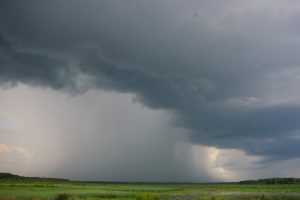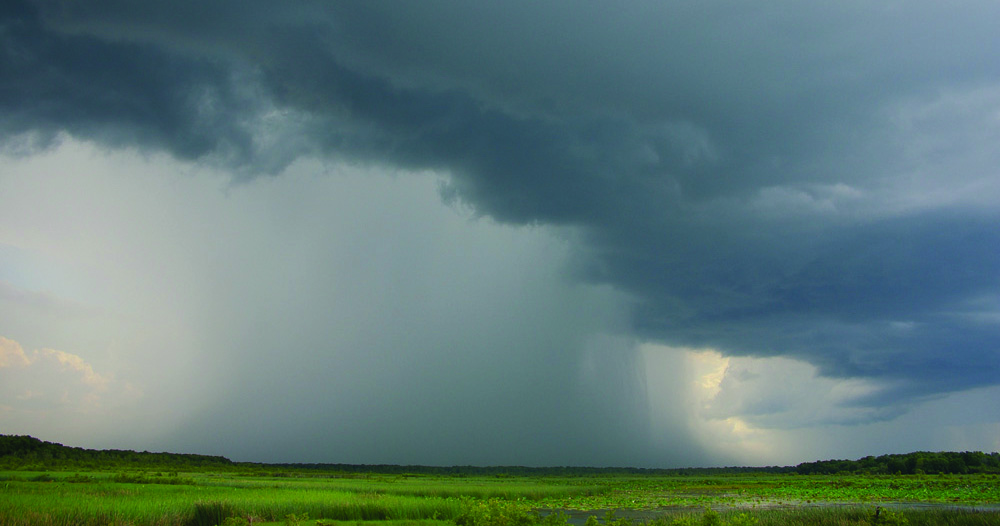By: John Miller

Fogg Dam Conservation Reserve on March 30, 2008. Photo credit: Bidgee / CC BY 3.0
Beekeeping is stormy. A beekeeper is justified fretting over myriad threats big and small. I have (finally) learned: There is no point fretting over the weather. It took a long time to stop fretting over uncontrollable matters (I still have lapses). It does not matter how hard we stare at the radar.
What did we stare at before there was no radar to stare at? 40 years ago I received a monthly summary of top and sub-soil conditions across North Dakota. It was a dreary, grainy accumulation of broad swath, mostly accurate reportage by state-wide observations. The data was congregated, then mailed to subscribers. I awaited arrival of the report to excuse the poor production we experienced in 1980 and 1981. Miserably dry conditions sapped the soil moisture. It was my tree to hide beneath, explaining to my boss why it wasn’t me, personally and directly responsible for the failed crop. It was the weather; my tree shelter.
Beekeepers usually look for a bigger tree; a safer tree to shelter beneath. I’m not speaking literally. Politicians are like beekeepers in one way; they too like scurrying beneath the bigger political tree, the bigger politician, the flawed policy to shade the politician’s fears – transparency and honesty.
Ronald Reagan once said, “The closest thing to eternal life on this planet is a government program.” How true. Shelter from the storm. A big tree. We have USDA programs. Well-intended programs that historically and currently do the exact opposite of how a healthy industry operates.
We have the Farm-Stored Program. In the late 70’s, inflation raged at 12%. The Carter-era inflation created an inverse market curve. It was more profitable for beekeepers to forfeit the honey crop (pledged as collateral for the loan) to The Commodity Credit Corporation (CCC) than pay off the loan, and then attempt to sell the crop. USDA was overwhelmed with honey it did not want, need or had any idea what to do with. Forfeited honey was stored in beekeeper warehouses for a storage fee. Program costs exploded. The answer?
USDA contracted with honey packers to bid on (at loan-neutral price points) to procure, pack, and deliver the honey to USDA food programs. A few resourceful packers immediately imported honey for far less money than the CCC honey available to bid on. Canadian and Mexican imported honey was packed and delivered as ‘Product of U.S.A.’ to USDA storage facilities – to be given to schools, senior centers and food banks – further undermining the domestic honey market. The domestic honey that was supposed to be packed – it languished in beekeeper buildings – unaudited – and earning no storage fee because the honey was supposed to have been shipped, packed and delivered as described above. There were no audits, no on-site inspections – in short; if you were a scoundrel, it was a no penalty playpen.
Today, we have The Emergency Livestock Assistance Program (ELAP). Can we be honest? ELAP provides a stipend to beekeepers, rewarding poor beekeeping. It is a self-reporting program – that incentivizes bigger losses. There are no audits. ELAP is now a commercial beekeeping bedrock spreadsheet entry. It is true, the beekeeper must ‘document’ losses.However, few Farm Service Agency (FSA) employees have the hat, veil, hive tool and smoker to crack a beehive cover, let alone the bandwidth to understand why an operation suffered a 2021 46% colony loss; a 53% colony loss in 2022; a 56% colony loss in 2023. Call it inflation.
It’s not FSA’s fault. It is the Legislation; the product of the spectacularly late 2023 Farm Bill. The political sausage-making where politicians hide beneath the big food-safety/nutrition/voter attraction tree instead of developing real agriculture policy. It’s another example of beekeepers trading independence with the expectation that government will competently provide solutions. The social contract in dysfunction. The ELAP program was authorized in 2014; then amended in 2018; and is today enshrined in the Farm Bill.
Perhaps the storm that most rocks the American honey market is the global nature of honey production. Global honey market chicanery damages American honey producers, and consumers. We are in the midst of the third anti-dumping action brought under the Tariff Act of 1930. Previous efforts focused on raw honey imported from other countries, primarily in Asia. Call it funny hunny. Imported funny hunny is imported at far below U.S. production costs.
American beekeepers operate in one of the most expensive production environments on earth, perhaps lagging only German production costs. Organizations brought action through the U.S. Commerce Department for relief through imposition of tariff; earning relief. Each time, the crooks are two steps ahead of the cops. This time around, in 2024, funny hunny merchants relabel their product as ‘finished honey’ – ready for the American 55-gallon barrel honey consumer. Simply re-labeling the product as ‘finished honey’ instead of a ‘raw agricultural product’ – tariff circumvention once again besets – distorting the American honey market – mis-informing American consumers and astonishingly – there are U.S. honey packers who legally buy, blend, and market this stuff. Legal Chicanery. A big tree to hide beneath.
#1 Dakota Clover offers are $1.65/lb.
There is a perverse relationship between the importation of funny hunny and ELAP losses. A convoluted example of the Law of Economics.
There is another path. It is called excellence in beekeeping. In America today, there are outfits achieving 90% overwintering success. This is an excellent example of what C. P. Dadant referred to as ‘the relentless attention to detail’. In 2024, 90% overwinter survival equals 2025, 90% rentable units in almond orchard pollination services. Costs are high to achieve 90% survival. Beekeepers must practice, relentlessly the 2% threshold of Varroa infestation. Hives must be fed. Beekeepers feed a lot of $30,000 a tanker loads of syrup. We feed more calories than we harvest; by far. Transportation costs are eye-watering. The long-discussed ratio of 1 skilled beekeeper per 800 hives, or is it 900 hives, or is it 1,000 hives is relevant – no it’s crucial. Labor costs are high; and going higher. The cost of modern, reliable rolling stock seems like a never-ending J-curve.
How is excellence in beekeeping rewarded? It isn’t.
USDA is charged with keeping the American food supply secure. It is fundamental. So is beekeeping. Beekeeping and the food security provided by billions of bees visiting trillions of blossoms on dozens of grown crops is fundamental to our nations well-being. No argument.
The agricultural policy argument is over how to keep the food supply secure.
The other path is an outright subsidy. USDA cuts checks to beekeepers based on successful colony husbandry. Audit the numbers. The more colonies surviving winter, the more remunerative to the beekeeper. It is inverse to ELAP. It obviates anti-dumping. It is a defensible moat – a term describing an advantage a company or industry enjoys over the competition. Examples of sturdy moats include innovation, patent protections, superb customer service – and no chicanery. Moats are chicanery kryptonite.
Take a 15,000 colony commercial beekeeping operation.
A sliding scale incentive rewards success.
The outfit with 90% overwintering success begins the new year with 13,500 colonies.
The earned reward for this level of colony husbandry is $100 per colony.
The beekeeper is free to choose if he restores, expands or shrinks his outfit during the season.
The outfit with 80% overwintering success begins the new year with 12,000 colonies.
The earned reward for this level of colony husbandry is $80 per colony.
The beekeeper is free to choose if she improves overwintering success during the season.
The outfit with 70% overwintering success begins the new year with 10,500 colonies.
The earned reward for this level of colony husbandry is $70 per colony.
The beekeeper is free to choose the path of recovery, expansion or mediocrity.
The outfit with 60% overwintering success begins the new year with 9,000 colonies.
The earned reward for this level of colony husbandry is $60 per colony.
The beekeeper is free to choose his response.
The arithmetic is simple.
So is the idea.
The idea is to reward success.








